OR/14/043 Site description - Blaen Onnen: Difference between revisions
m 1 revision imported |
|
(No difference)
| |
Latest revision as of 08:16, 5 April 2016
| Farr, G, Graham, J, and Stratford, C. 2014. Survey, characterisation and condition assessment of Palustriella dominated springs 'H7220 Petrifying springs with tufa formation (Cratoneurion)' in Wales. British Geological Survey Internal Report, OR/14/043. |
Introduction
Blaen Onnen is located midway between Mynydd Llangatwg and Mynydd Llangynidr, on the B4560 Beaufort to Llangynidr road (SN1574216878) at an elevation between 432 and 419 maOD. The site is similar to Foel Fawr/Herbert’s Quarry in that it is associated with past quarrying activities and is closely associated with lime spoil from the adjacent, and now mothballed Blaen Onnen Quarry.
Geological and hydrogeological data
The main area of tufa deposit is extensive enough to be mapped on the 1:50 000 geological map (Sheet 231 Merthyr Tydfil). It occurs in a small hollow that runs north-south parallel to the main road. The tufa has been deposited at the base of the hollow that has been cut down into the Carboniferous Abercriban Oolite Supgroup which is underlain by the Cwmyniscoy Mudstone Formation (‘lower limestone shales’). The area is well known for its karst development and an extensive area of sink holes and shake holes occurs on Mynydd Llangatwg and Llangynidr. Extensive lime spoil and waste forms spoil mounds to either side of the main road. A hand auger hole made in a ‘central island’ of Palustriella commutata surrounded by runnels proved 5cm of mineral soil underlain by 20 cm of carbonate rich gravel comprising eroded tufa clasts. At 30cm the material becomes very hard and the hole was terminated.
Blaen Onnen has several pathways for water to enter the site. At the top of the site near the road there is spring/seepage and this is also contributed to by a drain that takes runoff water from the entrance road to the quarry, under the main road and into the site. The drain was not flowing during the site visit (26/11/2013) however there was evidence that during rainfall the drain would be in operation. Inflows to the site could also include surface runoff from the adjacent main road. Seepages and springs occur along the base of the small valley from both the east and west. The contact of the Cwmyniscoy Mudstone and Abercriban Oolite formation in this area may influence the occurrence of springs and seepages. Diffuse seepages principally occur at the base of the historic spoil tips. Combined, the waters flow in runnels ultimately forming the headwaters of a tributary of the Nant Cwm Onnau.
Two samples were collected at Blaen Onnen. Sample BO1.1 was obtained from the spring head at the top of the site (SN1569816947) and sample BO1.4 from a Palustriella dominated runnel within the main area of the site (SN1574216878). Neither of the two samples showed elevated levels of nutrients and both nitrate and phosphate were close to their lower limits of detection. The dominant ions are calcium (77.4–82.8 mg/l) and bicarbonate (228–268 mg/l) although sodium (30.7–37.9 mg/l) and chloride (60.4–73.8 mg/l) are also present in significant amounts. Field readings of pH across the site ranged from 7.16–8.10.
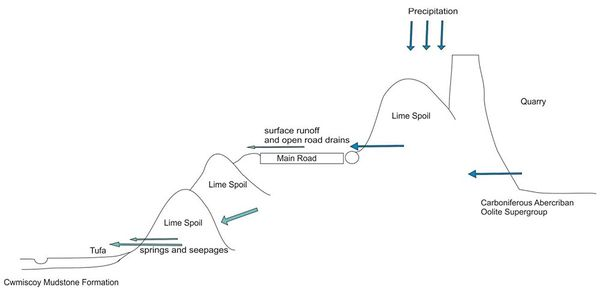
Land use and pressures
The small gully in which the site is situated is located directly below the main road (B4560) that runs from Llangynidr to Beaufort/Rassau and is next to the mothballed ‘Blaen Onnen Quarry’. Runoff from the road and the entrance into the quarry is diverted into open roadside drains and this runoff is channelled under the road and enters the top of the site via a plastic pipe. Direct surface runoff from the road is also possible. The land surrounding the site is sheep and horse grazed. There is substantial poaching across the area. There is no evidence for burning or obvious signs of nutrient enrichment at any part of the site. It is unlikely that there are any groundwater or surface water abstractions in the immediate area and there does not appear to be any dewatering taking place in the quarry.
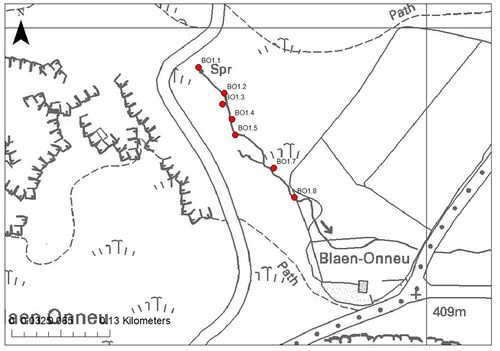
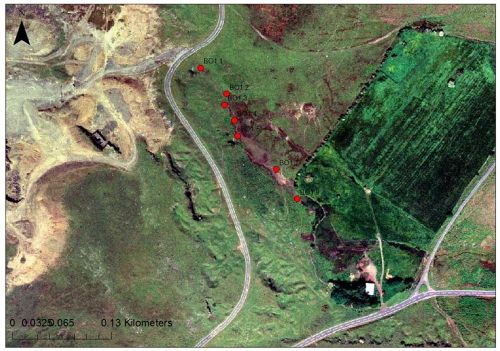
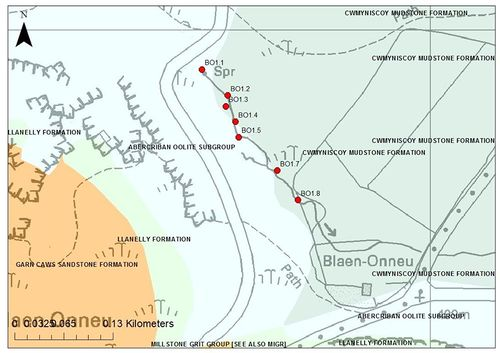
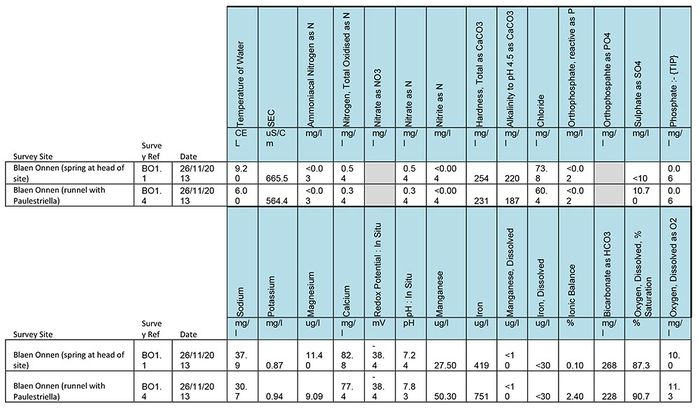
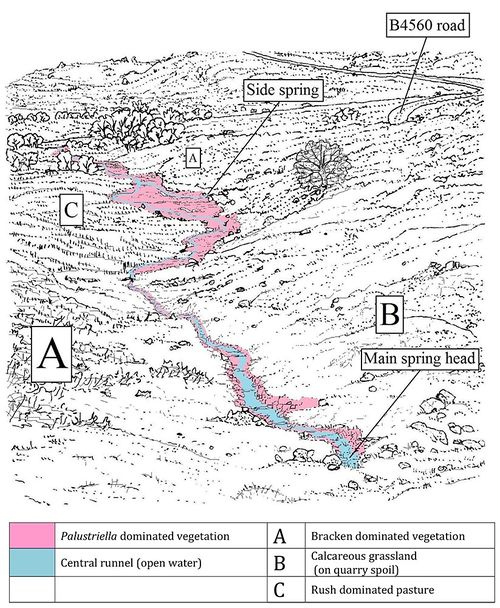
Vegetation (spring) of Blaen Onnen
Palustriella falcata dominated short vegetation between 1–3 cm height forming wide stands either side of a small winding runnel following the gentle dip of a small valley. The site has a single spring source and a number of small side springs but quickly forms a single central channel. The upper spring heads are notable for there absence of Palustriella falcata and dominance of Cratoneuron filicinum, Apium nodiflorum Calliergonella cuspidata, Philonotis fontana but quickly transform into rich Palustriella falcata flushed vegetation further down the slope. Locally, large stands of Campylium stellatum occur with Fissidens adianthoides, Scorpidium cossonii, Philonotis calcarea, occasional Bryum pseudotriquetrum, Leicolea badensis and with Scorpidium cossonii occurring as the dominant species along the sides of the main central channel. The main winding central channel is relatively deep lower down (to 15 cm at the time of survey during a period of fine weather) with crystal clear water and a good assemledge of aquatic flowering plants including Nasturtium officinale s.l., Apium nodiflorum, Myosotis sp., Mentha aquatica, Ranunculus flammula, Glyceria fluitans and locally dominant stands of Potamogeton polygoniferous.
| Agrostis stolonifera | R (<1%) |
| Anagallis tenella | R |
| Aneura pinguis | F |
| Apium nodiflorum | R |
| Bellis perennis | R |
| Bryum pseudotriquetrum | O |
| Calliergonella cuspidata | R |
| Campylium stellatum | A |
| Cardamine pratensis | R |
| Carex demissa | O |
| Carex flacca | O |
| Cratoneuron filicinum | O |
| Ctenidium molluscum | R |
| filamentous algae (Chlorophyta) | R |
| Fissidens adianthoides | R |
| Galium plaustre ssp. plaustre | R |
| Glyceria fluitans | R |
| Hydrocotyle vulgaris | R |
| Juncus acutiflorus | O |
| Juncus effusus | R |
| Juncus inflexus | R (<1%) |
| Jungermannia exsertifolia ssp. cordifolia (non fertile) | R |
| Leicolea badensis | R |
| Mentha aquatica | R |
| Myosotis sp. | R |
| Nasturtium officinale s.l. | R |
| Palustriella commutata | O |
| Palustriella falcata | A |
| Pellia endiviifolia | R(<1%) |
| Philonotis calcarea | R |
| Philonotis fontana | O |
| Potamogeton polygonifolius | R |
| Preissia quadrata | O |
| Ranunculus acris | R |
| Ranunculus flammula | R |
| Riccardia multifida | R(<1%) |
| Rivularia haematites | R |
| Sagina cf nodosa | R(<1%) |
| Scorpidium cossonii | A |
| Scorzoneroides autumnalis | R |
| Taraxacum sp. | R |
| Veronica beccabunga | R |
| Wahlendbergia hederacea | R(<1%) |
Calcareous rocks within the area of flush/spring but above level of seepage water supporting occasional acrocarpous calcareous species.
| Ditrichum gracile | R |
Vegetation adjoining spring
Short sheep grazed calcareous grassland (to 5 cm height) overlying old mining spoil and dominated by Ctenidium molluscum. A small number of other species are prominent including Agrostis stolonifera, Bellis perennis, Calliergonella cuspidata, Plantago lanceolata and Prunella vulgaris.
| Achillea millefolium | R |
| Agrostis stolonifera | O |
| Bellis perennis | O |
| Calliergonella cuspidata | O |
| Cirsium arvense | R (<1%) |
| Craex flacca | R |
| Ctenidium molluscum | A |
| Cynosurus cristatus | R |
| Ditrichum gracile | R |
| Festuca ovina | R (<1%) |
| Fissidens dubius | O |
| Hypnum cupressiforme | O |
| Lotus corniculatus | R |
| Plantago lanceolata | O |
| Prunella vulgaris | O |
| Ranunculus repens | R (<1%) |
| Rhytidiadelphus squarrosus | R |
| Trifolium repens | R (<1%) |
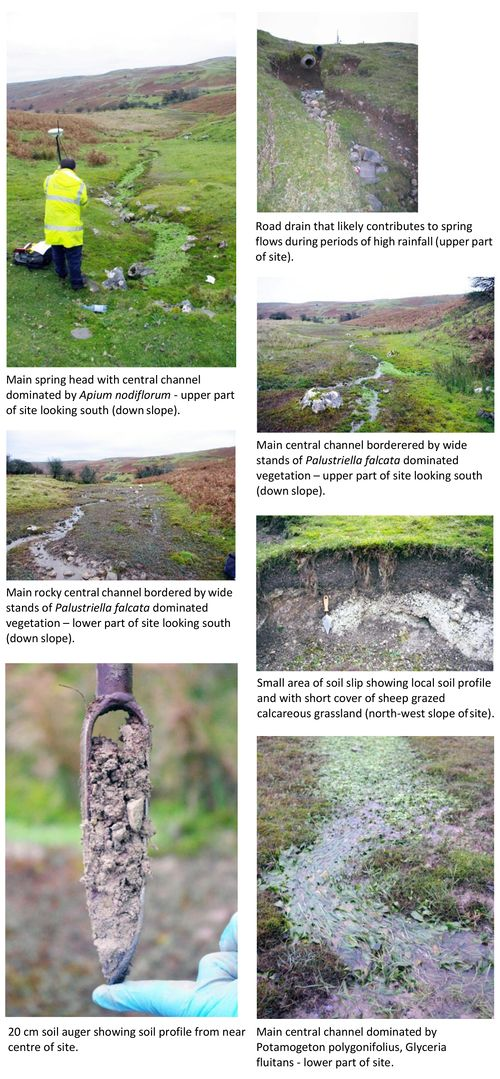
Condition assessment
The overall assessment is that Blaen Onnen should be classified as being in favourable ecological and hydrogeological condition.